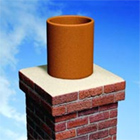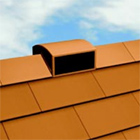The flue is the passage where toxic gases and smoke are removed from the house, better know as a chimney. The first job you need to undertake before picking your stove or gas fire is to identify what kind of flue your house has.
Your choice of stove is determined by the flue, you will be able to identify which flue type you have, from the six different types by looking outside at external wall or at your roof.
 Brick Chimney or Class 1 Flue
Brick Chimney or Class 1 FlueBrick chimneys have a flue that will be deep enough for all types of fires, all fires from slim fitting to deep fires will be accommodated by the flue. Class 1 brick flues will have a minimum diameter of 7 inches but generally have a 9 inch diameter chimney. Open fires require a minimum 8 inches, but many solid fuel and gas stoves require a minimum 5 inch flue.
Class 2 pre-fabricated flues will be located in the same position on the roof where brick chimneys are. This type of flue is suitable for most types of gas stoves as the depth of these is usually sufficient. This type of flue normally has a diameter of 5 inches which is enough to accommodate most types of gas appliances.
 Pre-cast Flue
Pre-cast FluePre-cast flues can be found on most modern houses, these flues are suitable for electric, slim line gas fires and stoves. Spacer kits are available to those who wish to have a fuller depth gas fire but unfortunately solid fuel fires or those with an open basket are not suitable for pre-cast flues.
 Power Flue
Power FlueFan or Power flues do not use a chimney or any type of roof outlet, instead they are mounted on the outside wall of your house. Power flues have an electric fan built into them which is used to draw the gases to the outside. These are normally used with open front gas fires, this increases the range of gas fires you can choose from, these fires must have an electricity supply to make them work which acts a safety mechanism. Not usually associated with stoves, but rather open fronted gas fires.
If you do not have a flue or chimney in your house, you will have to look for an appliance which does not require a flue, ‘flueless’. This type of appliance has a built in catalytic converter which removes harmful carbon monoxide and only releases water vapour and carbon dioxide. You will not require any building work to be carried out on your home if you have adequate ventilation. Minimum ventilation requirements are between 23 – 40 cubic metres depending of the fire you choose.
 Balanced Flue
Balanced FlueAnother option for houses without flues or chimneys is a Balanced Flue Gas Stove. These fires have a sealed front but air can be drawn into the fire and the exhaust gases are passed through a vent in the outside wall. Some leading British manufacturers build balanced flue stoves alongside their conventional gas stoves.
If you have any doubt or questions about which flue type you require then please contact us and our experienced staff will be more than happy to help.